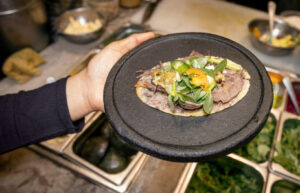Mexico City—A Feast for All Senses
There are cities where the food is good, and then there are cities where food is everything. Mexico City (CDMX), the country’s pulsing capital, belongs firmly in the latter category. As one of the world’s most electrifying culinary destinations, CDMX presents a gastronomic tableau that fuses age-old indigenous traditions, colonial influence, and avant-garde experimentation into a sensory whirlwind. The street food sizzles with authenticity, while the fine-dining landscape is bold enough to rival Tokyo or Copenhagen. From indigenous maize varieties to imported culinary philosophies, the richness of CDMX’s food scene defies easy classification—it’s living heritage, art, and revolution all at once.
This editorial takes you inside the city’s most unforgettable dining experiences—each a vignette of cultural, sensory, and emotional resonance. From the communal storytelling of Expendio de Maíz Sin Nombre, to the modernist spectacle of Lorea, and the time-honored rituals at Limosneros, we present a curated look into Mexico City’s culinary avant-garde.
Expendio de Maíz Sin Nombre: The Spiritual Heart of Maize
Tucked away in Roma—one of Mexico City’s most culturally potent neighborhoods—is Expendio de Maíz Sin Nombre, a restaurant that feels less like a venue and more like an act of reverence. There is no sign outside, no menus inside, and certainly no marketing. The experience begins the moment you step into the dark, intimate space, where an open kitchen dominates the center like a ceremonial altar. No reservations are accepted; seats are given to those who wait with intention.
What makes Expendio exceptional isn’t its mystery—it’s its purity. Founded on the ancestral importance of maíz, or corn, the restaurant treats its ingredients with spiritual gravity. Every dish is built around seasonal and locally sourced components, but there’s no script. The chefs prepare what is available—often right in front of you—making each meal unrepeatable. On any given day, you might be served smoked masa cakes with wild quelites, a huitlacoche-stuffed tortilla wrapped in hoja santa, or tamales steamed over volcanic stone.
The format is family-style, with communal dining that brings strangers together. Diners are not passive recipients, but engaged participants in an edible narrative. Food is presented with the reverence of oral tradition: explained, contextualized, and shared until guests signal they’ve had enough. There are no checks with itemized bills—only an invitation to honor the experience.
In a city where hype often eclipses heritage, Expendio de Maíz feels like a quiet act of rebellion. It resists commodification in favor of comunidad, returning Mexican cuisine to the soil, the hearth, and the people.
Lorea: Where Modernism Meets Mexican Identity
If Expendio is Mexico’s culinary soul, then Lorea is its philosophical brain. Also situated in Roma Norte, Lorea is the creation of Chef Oswaldo Oliva, a culinary visionary who honed his skills at Mugaritz in Spain before returning to Mexico to found a space that challenged both himself and his diners.
Here, the dining room resembles a minimalist art gallery—pared-back and precise. At the heart of the space lies an open kitchen, its transparency a manifesto in itself. Lorea doesn’t aim for theatricality; it cultivates presence. Guests are seated at intimate distances from the kitchen, where they can observe the choreography of plating and the finesse of preparation.
The restaurant’s tasting menu rotates seasonally and feels like a carefully scored symphony, each course revealing a new possibility for familiar ingredients. Think of tuna tartare in fermented chile water, or creamy maize espuma topped with smoky duck confit. At Lorea, ingredients aren’t simply sourced—they’re interrogated and abstracted until something wholly new is born.
Wine and cocktail pairings are given equal care. Curated by expert sommeliers, the beverage program amplifies the experience with native wines, small-batch mezcals, and inventive fermentations. There is a notable emphasis on storytelling—each pairing explained with regional context and production anecdotes, reinforcing the menu’s status as both performance and pedagogy.
What Lorea offers is less a meal and more a gastronomic meditation. It compels diners to ask: What is Mexican cuisine when stripped of iconography and reimagined as abstract art? For those willing to engage, the answer is as layered as a mole negro—both ancient and brand new.
Limosneros: Time-Travel Through Taste
Where Expendio draws from oral tradition and Lorea from conceptual rigor, Limosneros reclaims the culinary architecture of Mexico’s colonial past. Set in a 17th-century Spanish colonial building in the city’s Centro Histórico, the restaurant’s atmosphere alone is worth the reservation: volcanic stone walls, arched brick ceilings, and artisanal lighting transport diners to a Mexico suspended between epochs.
But make no mistake—this is no mere nostalgia project. Helmed by Chef Atzin Santos, Limosneros reinterprets classic dishes with precision and flair. Its taco tasting menu is a revelation, offering everything from suckling pig confit with cacao mole to ant larvae with smoked chile salsa. Ingredients are indigenous and bold—grasshoppers, wild mushrooms, heritage maize—rendered with contemporary sophistication.
The beverage program is equally ambitious. Limosneros houses one of CDMX’s finest collections of artisanal agave spirits, and its curated mezcal flights double as a deep dive into regional production methods, agave varietals, and ancestral distillation techniques.
There is also a commitment to sustainability here that feels forward-thinking. Ingredients are locally and ethically sourced, and nearly all of the décor—ceramics, textiles, glassware—are made by Mexican artisans. At Limosneros, dining is an act of cultural preservation, but it’s also an act of innovation.
Other Notable Mentions: The City’s Expanding Palette
While the spotlight rests firmly on the three establishments above, Mexico City is too vibrant to stop there. The following restaurants are equally deserving of acclaim and offer perspectives that widen the city’s culinary lens:
Quintonil
Owned by Jorge Vallejo and ranked among the World’s 50 Best Restaurants, Quintonil presents polished, high-concept dishes that remain deeply connected to Mexican terroir. Its crab tostada with habanero mayonnaise and cactus sorbet are unforgettable.
Pujol
Chef Enrique Olvera’s globally revered temple to Mexican gastronomy remains a rite of passage. Though known for his famous taco omakase and mole madre, Pujol also challenges guests to reflect on Mexico’s colonial scars and indigenous strength through food.
Sud 777
Set in a lush garden setting in the Pedregal district, Sud 777 is a hybrid of urban cool and organic earthiness. Chef Edgar Núñez brings a vegetable-forward philosophy that’s both elegant and ethical.
Contramar
Beloved for its casual seafood focus, Contramar excels at coastal simplicity. Their tuna tostadas with chipotle mayo are a citywide obsession, and their grilled fish preparations show a mastery of balance and technique.
The Future of Food in CDMX
Mexico City is not merely a culinary destination—it is a living archive of what food can be: memory, innovation, protest, communion. From the reverent simplicity of Expendio de Maíz Sin Nombre to the architectural ambition of Lorea and the temporal blend at Limosneros, the city reveals itself through its kitchens. These establishments are more than places to eat—they are cultural forums, laboratories of identity, and vessels of history.
And this is only the beginning. As young chefs continue to return from abroad with new techniques, and as indigenous ingredients gain the recognition they’ve long deserved, CDMX is poised to set the global standard for what food can mean in the 21st century.
Whether you’re visiting for the first time or are a lifelong chilango, the city’s food is a constantly evolving invitation—to taste, to learn, and to belong.
No comments yet.












